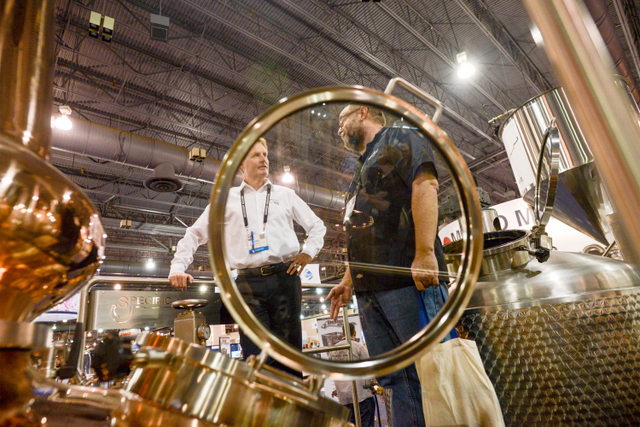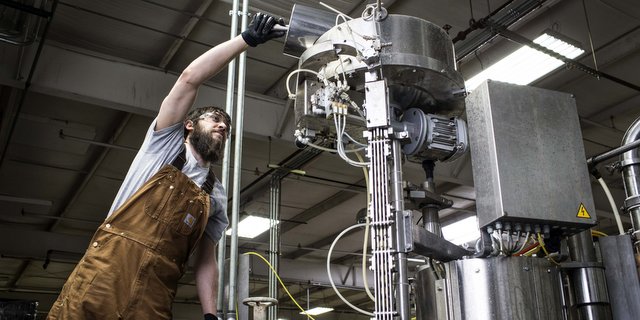
The $22.3 billion craft brewing industry is on a steady incline with growth of 12.8 percent in 2015 and no sign of slowing down. According to the Brewers Association, there are more than 5,000 breweries operating in the United States producing more than 24.5 million barrels. Craft breweries have a unique position in the brewing industry to capitalize on an ever-expanding fanbase through new and exciting approaches to beer.
However, one of the biggest challenges in a competitive brewing market is securing the right equipment to grow and succeed. Whether it’s vats, fermentation tanks, canning systems or keg washers, equipment is the most necessary component of a brewery — not to mention the most expensive. Offering a diverse line of beers and multiple taprooms, for example, requires brewers to maintain appropriate funds across the board; anything that changes in one location must be reflected elsewhere to maintain brand identity.
There are three main equipment challenges all breweries face:
1. Opening a brewery
Which equipment to use, whether to lease or buy and how to finance are daunting decisions that can easily yield short-term fixes, instead of effective, long-term solutions. Breweries require not only the equipment necessary to make the beer, but signage, point of sale equipment and, in the case of brewpubs, restaurant equipment as well. There are a number of factors to consider when opening a physical location.
Take Prestige Brewing, a N.C.-based brewery planning to open the doors of its first brewpub in May 2017. The brewery was started by a group of four friends who shared a dream to develop specialty herb-based and sour beers, paired with delicious food. The founders decided on herb-based and sour beers because of their uniqueness and to set their brewery apart from others in the crowded industry. They are currently working on brewing a sweet potato beer to continue their unique roster of flavors.
But opening a brewery is never an easy road, as the owners quickly realized in attempting to secure the equipment they needed to accommodate a full roster of beers and a full-scale pub. Like many brewers, Prestige Brewing had to find a method of financing that worked for them and choose the specific types of equipment needed to open the brewpub and make it successful.
2. Expanding
Expanding your brewery or brewpub, whether adding onto an existing space or opening a second location, is a large and expensive undertaking. Once again, as with opening a new brewery location for the first time, brewers must decide on new equipment and the method of securing it. In expanding and opening additional locations, breweries may also have to replicate equipment of the flagship location to ensure consistency of their products. Brewery capabilities must be reflected accurately across locations to create the same end product each time. Loyal customers want to recognize their favorite brewery by the look and feel of the space and by the beer they are drinking.
3. Adding a new menu item
Adding a new beer to the brewery’s lineup can require additional pieces of specialty equipment. For example, brewing a coffee flavored beer and brews made in wine-aged barrels require new types of equipment that a brewery may not have in their normal rotation. In many cases, these unusual or trend pieces of equipment are only offered by select vendors and may come at a steep price. While the need and desire to expand your offering may be there, the extra funds to purchase the equipment may not be.
To lease or buy?

Each of these three equipment challenges poses a different set of problems, but all three can be linked by one central issue: the search for financing.
We’ve established that breweries are expensive ventures that require an airtight business model to effectively scale operations and prepare for unexpected costs — especially those associated with equipment for opening a location, expanding or adding a new specialty beer to the roster. But when it comes to acquiring that equipment, should breweries lease or buy?
Purchasing equipment out of pocket is a significant expense and almost always liquidates any capital set aside for a rainy day. Financing or leasing equipment, on the other hand, is a great way to manage and preserve cash flow, while acquiring the necessary assets to run a successful and flexible business.
Unfortunately, when it comes to leasing, first-time brewery owners often have difficulty securing an equipment lease or financing by traditional means. Banks see first-time owner operators, particularly those in the competitive brewing industry, as high-risk investments, preferring to lend to established business owners with higher credit scores. In fact, only 3.7 million of the 36 million businesses in the United States that need equipment can get bank financing.
Prestige Brewing encountered this exact situation. The founders were turned away by bank after bank due to imperfect credit and the inherent risk of opening a brewery. Incorporating a full-scale restaurant into the brewery posed an even greater challenge, as the amount they originally set aside to open quickly increased. The founders became frustrated with the lack of financing options banks provided and began to worry their dream would never become a reality.
Equipment financing
In contrast to bank financing, equipment financing presents breweries like Prestige with new ways to finance the equipment they need, while preserving necessary cash flow. By counting the equipment as collateral for the loan or lease, equipment financing offers some of the best interest rates and payment terms for any type of equipment, regardless of a borrower’s time in business or credit score.
Equipment financing allowed Prestige Brewing to secure all of the equipment needed at terms and pricing that fit into their business model without the significant amount of interest associated with a traditional loan. Prestige was able to decide on the exact brewing equipment they needed to make their dream a reality while keeping funds on hand for unexpected costs.
“Being able to find the leasing that we needed gave us the ability to pursue that all-American dream,” said Co-Owner Kyle Kitsmiller. “For us, the smartest option was equipment leasing. We can turn around and rebuy it down the road, and it helps the bottom line by not having a huge loan with ton of interest. It made more sense to us and every way I ran the numbers.”
While opening and expanding a craft beer business can be challenging, those who tactfully choose the right financing solution and prepare for unexpected costs can make brewing a rewarding endeavor.
Cory Damm heads Strategic Partnerships and is also the general manager for the Food & Beverage and Fitness Vertical Market Groups at LeaseQ. He plays a significant role in identifying and building vertical market automation and integration solutions that benefit both equipment sellers and finance companies. Prior to LeaseQ, Damm founded LenderCloud.com an early competitor to LeaseQ. In 2012, Damm joined forces with LeaseQ as employee No. 1 bringing with him an out-of-the-box perspective on the equipment financing industry. Prior to LeaseQ, Damm was franchise finance manager at Direct Capital Corp. and Capital Sourcing Consultant at IFS Capital.





Leave a Reply
You must be logged in to post a comment.